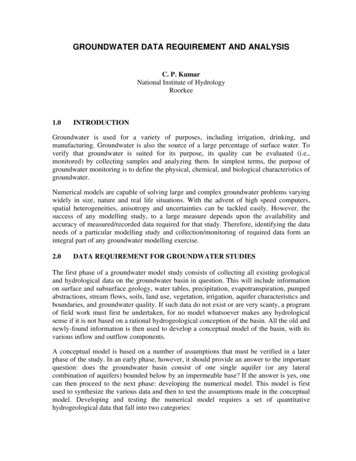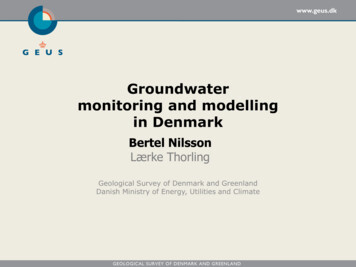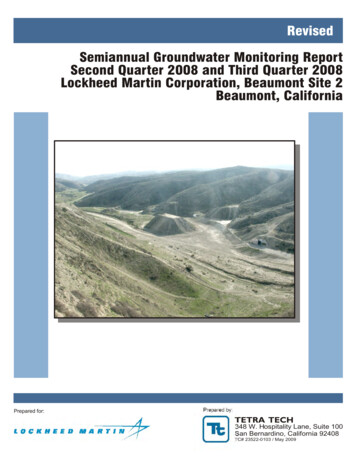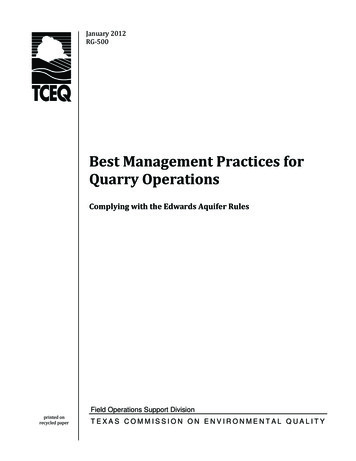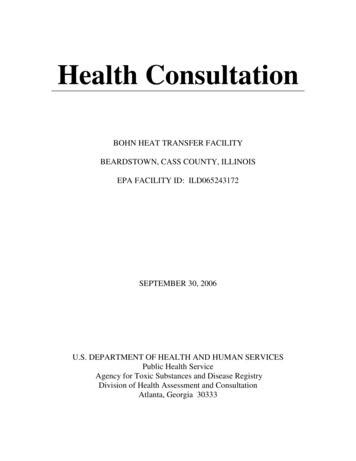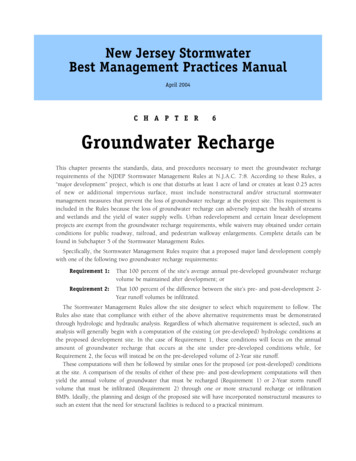
Transcription
New Jersey StormwaterBest Management Practices ManualApril 2004C H A P T E R6Groundwater RechargeThis chapter presents the standards, data, and procedures necessary to meet the groundwater rechargerequirements of the NJDEP Stormwater Management Rules at N.J.A.C. 7:8. According to these Rules, a“major development” project, which is one that disturbs at least 1 acre of land or creates at least 0.25 acresof new or additional impervious surface, must include nonstructural and/or structural stormwatermanagement measures that prevent the loss of groundwater recharge at the project site. This requirement isincluded in the Rules because the loss of groundwater recharge can adversely impact the health of streamsand wetlands and the yield of water supply wells. Urban redevelopment and certain linear developmentprojects are exempt from the groundwater recharge requirements, while waivers may obtained under certainconditions for public roadway, railroad, and pedestrian walkway enlargements. Complete details can befound in Subchapter 5 of the Stormwater Management Rules.Specifically, the Stormwater Management Rules require that a proposed major land development complywith one of the following two groundwater recharge requirements:Requirement 1:That 100 percent of the site’s average annual pre-developed groundwater rechargevolume be maintained after development; orRequirement 2:That 100 percent of the difference between the site’s pre- and post-development 2Year runoff volumes be infiltrated.The Stormwater Management Rules allow the site designer to select which requirement to follow. TheRules also state that compliance with either of the above alternative requirements must be demonstratedthrough hydrologic and hydraulic analysis. Regardless of which alternative requirement is selected, such ananalysis will generally begin with a computation of the existing (or pre-developed) hydrologic conditions atthe proposed development site. In the case of Requirement 1, these conditions will focus on the annualamount of groundwater recharge that occurs at the site under pre-developed conditions while, forRequirement 2, the focus will instead be on the pre-developed volume of 2-Year site runoff.These computations will then be followed by similar ones for the proposed (or post-developed) conditionsat the site. A comparison of the results of either of these pre- and post-development computations will thenyield the annual volume of groundwater that must be recharged (Requirement 1) or 2-Year storm runoffvolume that must be infiltrated (Requirement 2) through one or more structural recharge or infiltrationBMPs. Ideally, the planning and design of the proposed site will have incorporated nonstructural measures tosuch an extent that the need for structural facilities is reduced to a practical minimum.
Finally, once the analysis of pre- and post-development conditions has established the need for structuralrecharge (Requirement 1) or infiltration (Requirement 2) BMPs, the hydrologic and hydraulic analysiswould next focus on the actual design of such facilities. This process would include answering suchquestions such as: Should the required recharge or infiltration be achieved at a single facility or several locatedthroughout the development site? Should the facilities be located above or below ground? Which portions of the development site should be utilized to generate runoff to the facilities? What facility dimensions are required? Where should the facilities be located on the site relative to buildings, septic systems, propertylines, and other sensitive areas?This chapter presents the groundwater recharge information necessary to perform the hydrologic andhydraulic analysis required for Requirement 1 (maintaining pre-developed annual recharge volumes).Information necessary for the analysis required for Requirement 2 (infiltrating the increased 2-Year runoffvolume) is presented in Chapter 5: Computing Stormwater Runoff Rates and Volumes. Design informationregarding structural recharge and infiltration BMPs can be found in this chapter and Chapter 9: StructuralStormwater Management Measures.FundamentalsIn both the NJDEP Stormwater Management Rules and this manual, groundwater recharge is defined asprecipitation that infiltrates into the soil and is not evapotranspired. Instead, the infiltrated precipitationmoves downward to a depth below the root zone of the surface vegetation, where it cannot be removed bythat vegetation through uptake and evapotranspiration. At such a depth, it is considered available to enterthe soil’s saturated zone and become groundwater. The role of groundwater recharge in the overallhydrologic cycle is illustrated in Figure 6-1 below.Figure 6-1: Groundwater Recharge in the Hydrologic CycleSource: New Jersey Geological Survey Report GSR-32.New Jersey Stormwater Best Management Practices Manual Chapter 6: Groundwater Recharge April 2004 Page 6-2
According to the New Jersey Geological Survey (NJGS):The potential for natural groundwater recharge begins with precipitation (rain, snow, hail, sleet). Someof the precipitation never seeps into the soil, but instead leaves the system as surface runoff. The waterthat seeps into the soil is infiltration. Part of the water that does infiltrate is returned to the atmospherethrough evapotranspiration. Evapotranspiration refers to water that is returned to the atmospherefrom vegetated areas by evaporation from the soil and plant surfaces and soil water that is taken up byplant roots and transpired through plant leaves or needles. Infiltrated water that is not returned to theatmosphere by evapotranspiration moves vertically downward and, upon reaching the saturated zone,becomes ground water. This ground water could be in a geologic material that is either an aquifer ornonaquifer, depending on whether it can yield satisfactory quantities to wells. (NJGS GSR-32)In addition to supplying water to wells, groundwater can also provide base flow to streams, wetlands,and other water bodies, directly affecting the ecology and geomorphology of these resources.The potentially adverse impacts of land development on groundwater recharge have long beenrecognized. From the description presented above, it can be seen that land development activities that eithercover permeable soils with impervious surfaces or reduce the soils’ permeability through disturbance andcompaction will reduce the rate of groundwater recharge that occurs under pre-developed site conditions.As noted above, such reductions in groundwater recharge can adversely impact streams, wetlands, andother water bodies by reducing the volume and rate of base flow to them. Reductions in groundwaterrecharge to aquifers can also adversely impact the yield of water supply wells. As a result, the New JerseyStormwater Management Rules require that pre-developed groundwater recharge rates be maintained atland development sites under post-development conditions.New Jersey Stormwater Best Management Practices Manual Chapter 6: Groundwater Recharge April 2004 Page 6-3
Computing Groundwater RechargeOverviewAs described above, the groundwater recharge requirements of the NJDEP Stormwater Management Rulescan be met by demonstrating that the average volume of precipitation that is annually recharged to thegroundwater at a major land development site under pre-developed conditions will be maintained followingsite development. As described in detail below, this can be achieved through a combination of naturalrecharge over the developed site’s pervious surfaces and artificial recharge through groundwater rechargeBMPs constructed at the site. The BMP volume is based on an average annual distribution of runoffproducing precipitation events at the site, the impervious drainage area to the BMP, and the losses that mayoccur to the infiltrated runoff before it can travel below the root zone of surrounding vegetation and becomegroundwater.The data and analytic procedures necessary to meet these requirements have been developed by the NewJersey Department of Environmental Protection (NJDEP) with assistance from the New Jersey GeologicSurvey (NJGS), the U.S. Geologic Survey (USGS), and professional consultants, and have been compiledinto the New Jersey Groundwater Recharge Spreadsheet (NJGRS), a Microsoft Excel-based computerspreadsheet program. The NJGRS is intended for use by site planners, designers, engineers, and reviewers todetermine average annual groundwater recharge amounts under both pre- and post-development siteconditions and to design the groundwater recharge BMPs necessary to maintain 100 percent of the predeveloped site’s annual groundwater recharge rate. Information regarding the NJGRS, including a detailedUser’s Guide, an example problem, and instructions on how to download the NJGRS from the NJDEPstormwater management website, is presented below. Details of the program’s theoretical basis, equations,and supporting databases are also summarized.In general, the analytic procedures utilized by the NJGRS to achieve compliance with the groundwaterrecharge requirements of the Stormwater Management Rules (described as Requirement 1 above) can besummarized by the following computational steps:1. Compute the average amount of annual groundwater recharge occurring over the landdevelopment site under pre-developed site conditions.2. Compute the average amount of annual groundwater recharge occurring over the landdevelopment site under post-developed conditions. Such site conditions should reflect the use, tothe maximum extent practicable, of nonstructural stormwater management measures at the postdeveloped site in accordance with the Stormwater Management Rules. Details of suchnonstructural measures are presented in Chapter 2: Low Impact Development Techniques.3. Compute any resulting annual groundwater recharge deficit by subtracting the post-developedannual recharge amount in Step 2 from the pre-developed annual amount in Step 1. This deficitrepresents the average annual amount of groundwater recharge that must be achieved at thedevelopment site through structural groundwater recharge BMPs.4. Determine the storage volume and related dimensions of the structural groundwater recharge BMPthat will be required to satisfy the average annual groundwater recharge deficit computed in Step3 above. In doing so, the BMP volume must be based on the average annual distribution of runoffproducing precipitation events at the development site, the size of the drainage area over whichthese events will occur (and from which runoff will be collected or captured for recharge), and theinfiltration, evapotranspiration, and other losses that may occur to the recharged runoff in theBMP before it can actually enter the groundwater.New Jersey Stormwater Best Management Practices Manual Chapter 6: Groundwater Recharge April 2004 Page 6-4
Theoretical Basis of ComputationsComputation of the average annual groundwater recharge at a land development site under either pre- orpost-developed conditions (as described above in Steps 1 and 2) can be performed with the New JerseyGroundwater Recharge Spreadsheet (NJGRS). This Microsoft Excel-based spreadsheet is based on the dataand computational procedures contained in the 1993 Geological Survey Report GSR-32: A Method forEvaluating Ground Water Recharge Areas in New Jersey developed by the NJGS. As described in the report,GSR-32 utilizes precipitation, soil, land cover, and climate data, and rainfall-runoff and mass balancecomputations to estimate average annual groundwater recharge amounts at sites within any New Jerseymunicipality under a variety of surface and development conditions. All pertinent GSR-32 databases andcomputational algorithms have been incorporated into the NJGRS. As such, use of the NJGRS is governed,in part, by the assumptions and limitations of GSR-32.Design of the required recharge BMP (as described in Step 4 above) to compensate for the developedsite’s groundwater recharge deficit (as described in Step 3 above) can also be performed with the NJGRS.The design computations in the NJGRS are based on a number of analytic techniques and databases.Conceptually, a groundwater recharge BMP will recharge the runoff it receives from its drainage area for allstorms up to a particular precipitation depth, which can be referred to as the BMP’s groundwater rechargedesign storm. While the recharge BMP will also receive runoff from larger storms, it will only recharge thatportion of the runoff that equals the Recharge Design Storm runoff. The remaining runoff from these largerstorms will overflow or otherwise bypass the BMP. It is important to note that the range of precipitationdepths typically involved in the design of a groundwater recharge BMP are relatively small when comparedto depths associated with runoff quality or quantity control. As a result, the NJGRS requires that the entiredrainage area to a recharge BMP be impervious, since pervious surfaces would typically not be able toproduce a sufficient amount of rechargeable runoff from such small precipitation depths.Assuming that all of the precipitation falling in a recharge BMP’s impervious drainage area can becollected and recharged (i.e., no runoff, infiltration, or recharge losses), computation of the BMP’s RechargeDesign Storm depth can be conceptually illustrated with the following conversion equation:Total AverageAnnual RechargeDeficitAnnual Sum of Recharge Design andSmaller StormDepths Recharge DesignStorm DepthxNumber ofLargerStormsThe above equation shows that, with appropriate precipitation data and ignoring all losses, the totalannual recharge deficit at a land development site can be converted to the sum of two precipitationamounts, both of which are based on a single groundwater recharge design storm. The first amount is thesum of all storm depths up to and including the Recharge Design Storm that would occur at the site in anaverage year. The second amount is the product of the Recharge Design Storm depth times the number oflarger storms that would also occur at the site in that same average year.Unfortunately, most of the ease and simplicity of the conversion equation shown above is gained throughits two assumptions: that appropriate precipitation data is available, and that all of the precipitation fallingon the BMP’s impervious drainage area can be recharged without loss. In reality, compiling suchprecipitation data for a specific land development site requires considerable effort and resources and mustbe repeated for each new development site. In addition, precipitation losses will occur and must be takeninto consideration in the design of a recharge BMP. As noted above, these losses, which will vary with thetotal precipitation depth, include those occurring in the conversion of precipitation to runoff, includingsurface storage, evaporation, and infiltration through cracks, joints, and seams in the drainage area’simpervious surface. Further losses will occur once the runoff is delivered to the recharge BMP, primarily inNew Jersey Stormwater Best Management Practices Manual Chapter 6: Groundwater Recharge April 2004 Page 6-5
the form of evapotranspiration by the vegetation above, beneath, and/or adjacent to the BMP. Furthercomplications arise when one attempts to estimate these variable losses. While equations exist to predictsuch losses for individual storm events, there are none readily available that can do so for an annualprecipitation depth.The NJGRS addresses these problems in several ways. Regarding the need for appropriate precipitationdata for all possible development site locations in New Jersey, the NJGRS developers compiled and analyzed52 years of daily precipitation data collected at 92 precipitation stations throughout New Jersey between1948 and 1999. To ensure a proper database, only precipitation depths greater than 0.04 inches wereconsidered, since this depth was considered the minimum amount necessary to produce runoff fromimpervious surfaces. All daily values at each station were sorted for each year and then averaged over the 52year period of record. Next, all values with the same rank were averaged across all 92 stations to produce anaverage annual series of 79 precipitation events for the state. Finally, this series was normalized by dividingeach event value by 46.32 inches, which was the average annual precipitation for the 92 stations. Thisproduced an average annual series of 79 precipitation events, expressed as a percentage of total annualprecipitation, that are analyzed individually by the NJGRS to compute the runoff, infiltration, and rechargelosses and the resulting annual groundwater recharge achieved by a recharge BMP at a land developmentsite in any New Jersey municipality.This average annual series of precipitation events for New Jersey is shown below in Figures 6-2 and 6-3.Figure 6-2 depicts the precipitation depth, expressed as a percentage of total average annual rainfall, of eachevent in the series in ascending order, while Figure 6-3 depicts, also in ascending order, the events’cumulative percentage of the average annual rainfall. More detailed information about each specific event inthe average annual series is contained in the NJGRS’ databases. The average annual precipitation seriesshown in Figure 6-2 is used by NJGRS to produce a site-specific, year-long series of design storms bymultiplying each event value in the series by the average annual precipitation in the municipality where therecharge BMP is located. Since the NJGRS also contains average annual precipitation values for each NewJersey municipality, the NJGRS user can generate this site-specific average annual design series simply byspecifying the municipality and county in which the development site is located.New Jersey Stormwater Best Management Practices Manual Chapter 6: Groundwater Recharge April 2004 Page 6-6
Figure 6-2: Average Annual Precipitation Series in NJGRSFigure 6-3: Cumulative Total of Average Annual Precipitation Series in NJGRSNew Jersey Stormwater Best Management Practices Manual Chapter 6: Groundwater Recharge April 2004 Page 6-7
Once an average annual design series is computed for the specific recharge BMP site, the NJGRS nextaddresses the problem of precipitation losses. As noted above, all of the possible losses that will occur, fromthe time the precipitation falls on the BMP’s impervious drainage area to when the recharged water movesbelow the root zone of the vegetation in or adjacent to the BMP, must be accounted for in order toaccurately compute the actual volume that will be recharged. Such losses can include infiltration and surfacestorage losses on the drainage area surface as the precipitation is converted into runoff, as well asevapotranspiration and infiltration losses as the runoff is converted to recharge within the BMP itself. Tocompute runoff losses, the NJGRS uses one of three equations depending upon the total depth of the event.These equations are applied to each event in the average annual design series to compute the resultantrunoff for each one. This resultant runoff is then used in additional equations that estimate the losses thatwill occur for each design event once the runoff enters the recharge BMP.When computing runoff losses for design event depths less than 0.0408 inches, the NJGRS assumes thatthe entire precipitation depth is consumed by surface storage, infiltration, and other losses and no runoff isproduced.For design event depths between 0.04 and 1.25 inches, the NJGRS uses the following equation tocompute runoff:Q 0.95 (P - 0.0408) 0.90where:Q Runoff Depth in InchesP Precipitation Depth in InchesFor design event depths greater than 1.25 inches, the NJGRS uses the NRCS Runoff Equation with aRunoff Curve Number (CN) of 98:Q (P – 0.04)2(P 0.16)where:Q Runoff Depth in InchesP Precipitation Depth in InchesAs noted above, the resultant runoff depth for each design event is then applied to specialized equationsdeveloped specifically for the NJGRS to estimate the losses that will occur to the runoff after it is stored inthe recharge BMP. These losses will depend upon a number of factors, including the climate at thedevelopment site, the specific vegetation and soil conditions at the recharge BMP location, and the depth ofthe BMP relative to the vegetation’s root zone. A complete description of the loss equations used in theNJGRS is presented in the program’s User’s Guide. By subtracting these losses from the stored runoff, theamount of runoff that is actually recharged for each design event is computed. The NJGRS then adds up therecharge amounts from each design event to obtain a total annual recharge amount, which is then comparedwith the average annual recharge deficit created by the development to determine whether the rechargeBMP’s performance is adequate. Similar to the computation of the average annual design series describedabove, the NJGRS’ loss computations are performed automatically each time the user provides newdevelopment site or recharge BMP data and then requests a BMP design update. The NJGRS will then eitherevaluate the performance of the proposed recharge BMP or, if requested, compute the effective BMP storagedepth or surface area necessary to offset the development’s annual recharge deficit.New Jersey Stormwater Best Management Practices Manual Chapter 6: Groundwater Recharge April 2004 Page 6-8
New Jersey Groundwater Recharge Spreadsheet (NJGRS)General InstructionsAs described above, the New Jersey Groundwater Recharge Spreadsheet (NJGRS) is a Microsoft Excel-basedcomputer spreadsheet program. It is typically used in a two step procedure, utilizing first the AnnualRecharge worksheet and then the BMP Calculations worksheet in the program. During the first step, theaverage annual groundwater recharge amounts at the site under pre- and post-developed conditions areestimated based upon site data provided by the user. From these estimates, the program computes theaverage annual groundwater recharge deficit caused by the site development that must be offset by agroundwater recharge BMP. During the second step, this recharge BMP is sized based upon user-specifiedinformation regarding both the BMP and its location at the development site. General information regardingeach step is provided below. Specific information about the program’s use and computation methods areprovided in the NJGRS User’s Guide, which is presented at the end of this chapter.It should be noted that, as a spreadsheet, certain cells of the program are reserved for user input whileothers provide intermediate and final results. All user input cells are shaded with a tan color whilespreadsheet output cells are shaded with gray. Only the tan, user-input cells should be changed. Inaddition, the spreadsheet contains several combinations of commands known as macros. While thesemacros are essential to the spreadsheet’s operations, they are unsigned and, as such, their presence mayconflict with the Excel program’s security settings in the user’s computer. These conflicts would beidentified to the user through an error or warning message immediately after opening the NJGRS. If suchconflicts are encountered, they can usually be addressed by setting the Excel macro security level toMedium. The user should determine whether this level of security is acceptable for their own system. The userwould then be prompted to enable the NJGRS macros each time the spreadsheet is opened.Finally, upon completing use of the NJGRS for a specific project, the user will be asked whether thechanges made during use should be saved. While such decisions are at the discretion of each user, it may behelpful for training purposes to retain the spreadsheet original settings, which match those in the NJGRSUser’s Guide. In this case, a copy of the revised NJGRS with project specific data entered can be saved witha project-specific name using the Save As command under File on the Excel command line.Annual Recharge WorksheetAnnual groundwater recharge at a land development site under both pre- and post-developed (or existingand proposed) site conditions can be estimated using the Annual Recharge worksheet in the NJGRS. Asdiscussed above, these estimates are based on the methodology contained in Geological Survey Report GSR32: A Method for Evaluating Ground Water Recharge Areas in New Jersey (GSR-32) developed by the NewJersey Geological Survey. In general, use of this worksheet requires the following user input:1. Name of municipality and county in which the project site is located (Cell C3). Upon input of thisdata through use of a drop-down list, the NJGRS will immediately display the average annualprecipitation and climate factor for the site’s municipality from the GSR-32 databases in theNJGRS. The user can also specify a project name, description, and date in the lines provided(Cells K1, K2, and K3).2. Land use and land cover (LULC) data for the site under both pre- and post-developed conditions.This data will consist of the area (in acres), LULC characteristics, and soil series name for up to 15land segments of the pre- and post-developed site. The NJGRS will issue a warning message if thetotal area specified under pre-developed conditions is different than post-developed. The LULCdata and soil series names are listed in a drop-down list next to the respective input cells. It isNew Jersey Stormwater Best Management Practices Manual Chapter 6: Groundwater Recharge April 2004 Page 6-9
important to note that the LULC categories in the drop-down list are based on those contained inTable 2-2 of the NRCS Technical Release 55 – Urban Hydrology for Small Watersheds. For acorrelation between these LULC categories and those in GSR-32, upon which the NJGRS is based,see Table 6-1 below.Table 6-1: NJGRS/TR-55 and GSR-32 LULC DescriptionsNJGRS/TR-55 LULC DescriptionsGSR-32 LULC DescriptionsBrushBrushGravel, DirtUnvegetatedImpervious AreasUnlandscaped DevelopedMeadow, Pasture, Grassland or RangeAgricultural – PastureOpen SpaceLandscape Open SpaceResidential 1 to 2 Acre1 - 2 Acre LotsResidential 1/2 to 1 Acre1/2 - 1 Acre LotsResidential 1/3 to 1/4 Acre1/8 - 1/2 Acre LotsResidential 1/8 Acre or Less1/8 Acre LotsRow CropAgricultural – GeneralSmall Grain or LegumesAgricultural – Cropland, LegumeUrban DistrictsLandscaped DevelopedWoodsWoodsWoods – Grass CombinationWooded – GeneralAs noted in the NJGRS User’s Guide, it is important to specify a site’s LULC characteristics as accuratelyas possible. Therefore, while a 1/4 acre residential site could be specified in the NJGRS by the “Residential1/3 to 1/4 Acre” LULC description in Table 6-1, it is generally more accurate to divide the site intoimpervious and pervious areas and specify each as a separate land segment in the NJGRS. For example, at a1/4 acre residential site with a total area of 10 acres consisting of 40 percent connected impervious and 60percent grassed surfaces and a single soil series, it would be more appropriate to specify the site’s LULCcharacteristics in the program as a separate 4 acre impervious area land segment and a 6 acre open spaceland segment. This separation of connected impervious and pervious areas is similar to the technique forcomputing runoff volume using the NRCS methodology in Chapter 5. It should be noted that the totalimpervious area for post-developed conditions displayed in Cell M23 of the Annual Recharge worksheetwill be based only on those post-developed land segments specified as impervious.When using the above technique, it should be noted that if any impervious areas at a development siteare unconnected (see Chapters 2 and 5 for complete details and requirements), the area used in theimpervious surface designations described above for these unconnected areas should be one half of theactual area. For example, if a site has 3 acres of directly connected impervious surface, but 2 acres ofunconnected impervious area, the total impervious area specified in the NJGRS can be 3 (0.5)(2) or 4New Jersey Stormwater Best Management Practices Manual Chapter 6: Groundwater Recharge April 2004 Page 6-10
acres. This 50 percent reduction in the size of unconnected impervious areas accounts for the runoff reinfiltration that can occur downstream of such areas and is consistent with the runoff computations for suchareas contained in TR-55. To keep the total site area correct, the user should remember to specify the“remainder” of the unconnected impervious area as a pervious one with the appropriate soil series andLULC based upon the actual pervious area downstream of the unconnected impervious area.It should also be noted that if a proposed recharge BMP will have a specific location within a landdevelopment site with similarly specific LULC and soil characteristics, that portion of the site should bespecified as a separate land segment on the Annual Recharge worksheet. This is true even if that segmentwill be covered with an impervious surface. Doing this will allow the NJGRS to more accurately computethe losses and resultant recharge at the BMP. More details are presented below in the NJGRS User’s Guide,including the need to specify this segment on the BMP Calculation worksheet.From the above, it can be seen that the more generalized Residential and Urban District LULCdescriptions in Table 6-1 above should be used only for general planning studies of groundwater rechargerequirements, particularly at sites with multiple lots of similar size and impervious coverage where each lotwill have a separate groundwater recharge BMP. Since the soil series in which each BMP will be located mayvary from lot to lot, the general LULC descriptions can be used to compute typical or general groundwaterrecharge requirements and BMP dimensions for the entire site. These general values can then be refined on alot by lot basis during later, more detailed project phases with s
Best Management Practices Manual April 2004 CHAPTER 6 Groundwater Recharge This chapter presents the standards, data, and procedures necessary to meet the groundwater recharge . atmosphere by evapotranspiration moves vertically downward and, upon reaching the saturated zone, becomes ground water. This ground water could be in a geologic .
